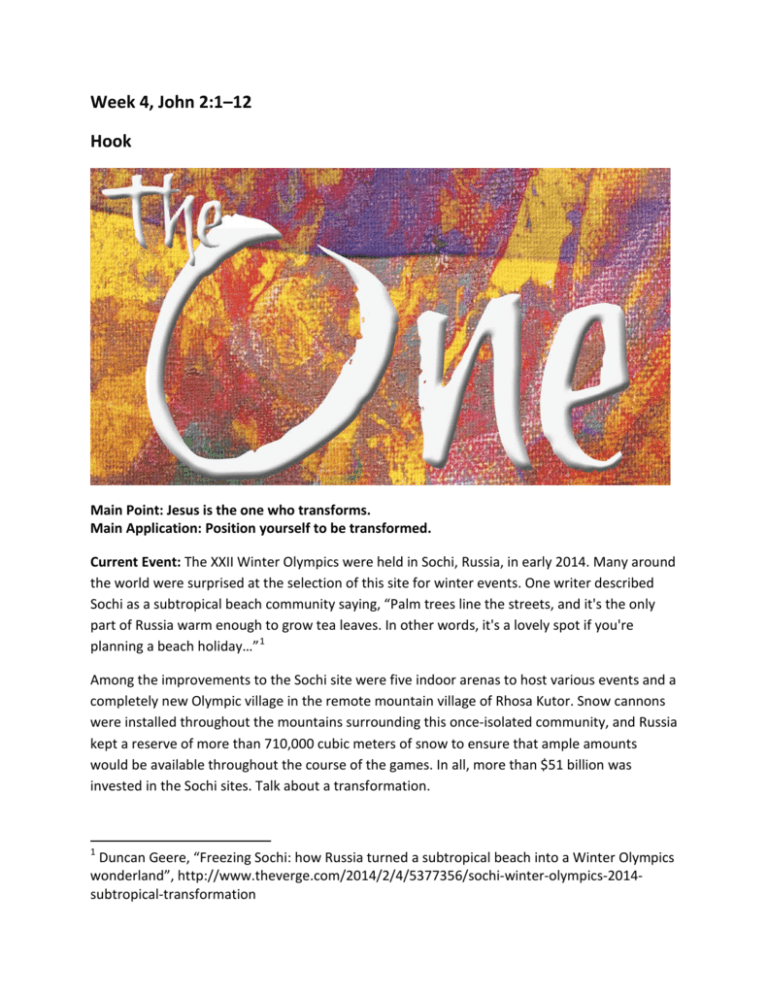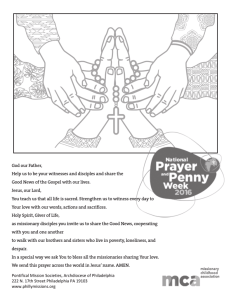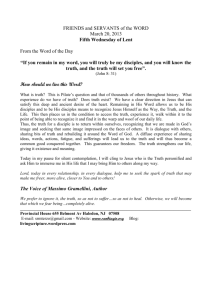Week 4, John 2:1–12 Hook
advertisement

Week 4, John 2:1–12 Hook Main Point: Jesus is the one who transforms. Main Application: Position yourself to be transformed. Current Event: The XXII Winter Olympics were held in Sochi, Russia, in early 2014. Many around the world were surprised at the selection of this site for winter events. One writer described Sochi as a subtropical beach community saying, “Palm trees line the streets, and it's the only part of Russia warm enough to grow tea leaves. In other words, it's a lovely spot if you're planning a beach holiday…” 1 Among the improvements to the Sochi site were five indoor arenas to host various events and a completely new Olympic village in the remote mountain village of Rhosa Kutor. Snow cannons were installed throughout the mountains surrounding this once-isolated community, and Russia kept a reserve of more than 710,000 cubic meters of snow to ensure that ample amounts would be available throughout the course of the games. In all, more than $51 billion was invested in the Sochi sites. Talk about a transformation. 1 Duncan Geere, “Freezing Sochi: how Russia turned a subtropical beach into a Winter Olympics wonderland”, http://www.theverge.com/2014/2/4/5377356/sochi-winter-olympics-2014subtropical-transformation Discussion Questions:Take a moment and discuss with your class some of the difficulties that are associated with transformation. How hard is it to change an existing situation into something new? Personal Story: Share a personal story of a transformation project that you were involved in and the lessons you learned from that experience. John 2:1–12 Book Main Point: Jesus is the one who transforms. Main Application: Position yourself to be transformed. Text Summary: Jesus performs His first sign. While there are several things that go on within today’s passage, the main component to highlight is the disciples’ belief in Jesus that follows His transforming the water into wine. This passage shows us that Jesus displays signs always in order that His glory be revealed and people come to belief in Him. John 2:1–5 (Read) Sub Application: Remember why Jesus came, to save sinners. Jesus attends a wedding at Cana and wine runs out. Mary asks Jesus to help, He responds His time has not yet come. Chapter 2 marks the beginning of Jesus’ public ministry. The miracle performed in this passage will be an example of the greater things that are to come; things Jesus mentions in 1:51. At the wedding at Cana, Jesus shows His glory in a very clear way; however, it is vital to understand the purpose in Jesus’ performing signs and why they are recorded in John’s gospel. John writes in 20:30–31 that he recorded Jesus’ signs and miracles so that people would believe that Jesus is the Christ. Jesus’ signs and miracles are meant to provide evidence of His glory. John chapter 2 opens with a tragic scene: the wedding has run out of wine. This isn’t good news for the hosts. In the culture of Jesus’ day, running out of supplies at a wedding could bring great disgrace and shame on the groom and his family. Moreover, the relatives of the bride may even bring a lawsuit.2 Knowing this, it allows the reader to see such compassion and grace in Jesus’ actions. The act of provision from Jesus will do more than supply wine to thirsty wedding attenders; it will also prevent great embarrassment to fall on the groom and his family. Mary, the mother of Jesus, tells Jesus about the situation with the wine. In response to the information, Jesus asks her what the situation has to do with Him. He says that His hour has not yet come. What hour is He talking about? Jesus isn’t saying there’s nothing He can do or that He won’t help. Throughout the gospel of John, Jesus’ “hour” refers to the moment at which God is fully glorified in Him. 3 This is the hour of His death. 2 D. A. Carson, The Pillar New Testament Commentary: The Gospel According to John. Eerdmans: Grand Rapids, 1990, p. 169. 3 Andreas Kostenberger, Baker Exegetical Commentary On the New Testament: John. Grand Rapids: Baker Academic, 2004, p. 95. At the wedding at Cana, Jesus wants to take precaution concerning what He does or does not do in a crowd of people, but not without reason. How do the signs and miracles Jesus performs prepare the way for His ultimate display of His glory in His death and Resurrection? Why do you think Jesus responds the way He does in verse 4? What does the phrase “my hour has not yet come” mean? How do you place an emphasis on the work of the Cross in your work? In your personal devotionals? In your family life? What instructions did Mary give to the servants? Why would Jesus choose to use servants to be a part of the miracle instead of His disciples? What are the characteristics of someone God will use? John 2:6–12 (Read) Sub Application: Let His works move you to greater belief. Jesus turns water into wine. The disciples witness the sign and believe in Jesus. Jesus gets involved but He does so discretely. Jesus transforms the water into wine behind the scenes. As read in verse 9, it’s only His disciples and the servants that know what He did. Jesus chooses to demonstrate His nature to only a select few. But more than a symbolic display of His mission to bring new life, the miracle shows Jesus’ divine glory. Verse 11 tells us this. As a result, the disciples believed in Him. This is central to this passage. His actions are not isolated. They are not removed from a greater purpose. Jesus doesn’t turn water into wine simply so the guests would have something to drink or just so the groom and his family weren’t embarrassed. By transforming the water into wine, Jesus’ purpose was to display who He was in order that His disciples believed in Him. While this act of Jesus served the groom and the hosts of the wedding greatly, it didn’t come close to doing for them what it did for the disciples. For the master of the feast, it brought a way out of great shame and embarrassment. For these disciples, it brought belief in the Son of God. Verse 11 tells us the disciples believed as a result of seeing Jesus’ sign. Why do you think Jesus cared more about the disciples seeing and believing His glory than making known to the other wedding attenders what He had done? Throughout Scripture, what are other moments when God has performed a sign to reveal Himself and His power? What does it show about Jesus that the wine He made from the water was superior to the wine already provided? Week 4, John 2:1–12 Took Main Point: Jesus is the one who transforms. Main Application: Position yourself to be transformed. Current Event: People are always looking for signs of activity in the heavens. During 2014, a celestial phenomenon known as “Blood Moon” will be, for some, another of those signs. When the moon crosses the earth’s shadow in just the right way, a total lunar eclipse occurs.4 Many spiritual people assume these occurrences relate to a specific message God is trying to communicate to people. Speculation will abound, as each of these eclipses will coincide with a key religious holiday. 5 This certainly makes for interesting debate, but what can’t be debated is that after Jesus performed His first miracle (or sign) in John 2, the text tells us that the disciples “believed” in Jesus from that point forward. Class Exercise: Ask your class to break into small groups and discuss the effect that miracles and signs can have in relation to belief. Ask them to write down and discuss how they would have responded if they had witnessed a miracle of Jesus in person. Lesson Conclusion: Genuine transformation comes from Jesus. An individual who seeks transformation must position himself to be transformed; if one is distant from Christ, genuine transformation will not occur. As one grows closer to Christ, understands why He came, witnesses His character, and allows that process to move one to greater faith, life transformation will take place. 4 Ben Brumfield and Todd Borek, Blood Moon Will be a Sight to Behold, Weather Permitting, http://www.cnn.com/2014/04/11/tech/innovation/blood-moon/ 5 Kenneth L. Waters, Sr., Does the Bible predict the Blood Moon, http://religion.blogs.cnn.com/2014/04/14/whats-up-with-the-blood-moons-prophecies/ Challenge: Every sinner needs transformation. Whether it is an unbeliever coming to faith in Jesus for the first time or a believer who is facing challenges, all need the life-altering hand of Jesus to bring change in ways that man simply cannot. Are you in a place where transformation can occur? Mary was aware that only Jesus could help a desperate situation. The servants were attentive to His words and obedient to His prompting. The disciples witnessed His work and allowed the miracle to shape their understanding of the nature of Jesus. As you leave, remind your class that salvation is the greatest miracle, the greatest transformation, that can occur in a person’s life. Challenge them to witness all that Christ has done and allow that to strengthen their belief. He can take the ordinary and transform it into the extraordinary.









